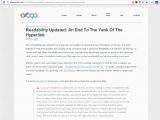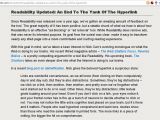The web has been evolving for the past two decades at a furious pace and, while most people would agree it has been for the best, the fact is, it’s as much of a mess as it was in the mid-nineties. That’s actually a good thing, for the most part, but there is no grand plan, no set-in-stone right and wrong way. The fact is, even the big guys, Google, Facebook, are mostly flying by the seat of their pants.
When it comes to editorial content, news stories, articles, opinion pieces, blogs, and so on, an ad-hoc pseudo-standard has evolved over the years and most publishers now offer a variation on the same theme. You get a central column with the actual content, one- or two-side columns with additional content, links and similar items. You have a header, a main menu, and so on. And then you have ads intertwined in various places to maximize their reach.
Even the cleanest sites can become quite cluttered. We’ve grown accustomed to this, but it doesn’t mean that that’s how it’s supposed to be. At least, that’s what the maker of Readability, arc90, a web design consulting firm, seems to think. Readability is a tool that re-formats any web page to make the content easier and more pleasurable to read.
By its own description, “Readability is a simple tool that makes reading on the Web more enjoyable by removing the clutter around what you're reading.”
Readability is offered ‘officially’ as a bookmarklet that works with any browser and does exactly what it’s advertised to do, it makes web pages more readable. It picks the actual content from a page, with remarkable accuracy, and presents it in a standard and simple format. Users can choose from several pre-defined styles and have an option in font-size, and margin-width.
The results are nothing short of amazing, headache-inducing webpages become a pleasure to browse through. For those doing a lot of reading online, or for those using an ‘irregular’ device, say a notebook, smartphone or an e-book reader, it proves a very helpful tool.
Since it’s a simple bookmarklet, it should work on virtually any browser out there. But if you want something even more seamless and you’re using Firefox or Chrome, you can get a Readability extension or add-on that comes with some added perks.
There are a couple of Readability extensions for Google Chrome named Readability and Readability Redux. None of them is official, from the looks of it, and the latter is more popular since it comes with customization options that enable users to select from the various styles available.
The Firefox add-on also named Readability and also not official is a solid implementation of the bookmarklet. Users can customize the styles and the add-on comes with a few handy keyboard shortcuts.
However, the bookmarklet was recently updated with a very interesting option, the choice to convert all links to footnotes. This may seem completely anti-web, but it actually makes sense. Links are certainly useful and are central to the way the web works, but they are distractions. And if you’re trying to get through a long article without jumping from tab to tab, you’ll probably appreciate this new option. Unfortunately, none of the add-ons supports this feature yet.
Whichever of the two browsers you use, both options, the bookmarklet and the native add-on/extension, have pretty much the same results and benefits. It mostly comes down to convenience and user preference. In any case, if you do a lot of reading on the web, you should definitely give Readability a try. [via Mozilla Links]

 14 DAY TRIAL //
14 DAY TRIAL // 

